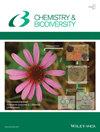作为生物活性杂环的新系列喹唑啉-噻唑和/或喹唑啉-三唑杂环的设计、合成、抗菌和抗真菌评估
IF 2.3
3区 化学
Q3 BIOCHEMISTRY & MOLECULAR BIOLOGY
引用次数: 0
摘要
在这里,环己酮、硫脲和 2,5-二甲氧基苯甲醛之间的一锅反应首先制备出六氢喹唑啉-2(1H)-硫酮 4,然后与水合肼反应生成相应的 2-肼基六氢喹唑啉 6。当六氢喹唑啉-2(1H)-硫酮 4 分别与 1,2-二溴乙烷、氯乙酰氯、溴乙酸、溴乙酸/4-氯苯甲醛、2-溴丙酸、溴氰乙酸乙酯和/或溴丙二腈反应时,得到了噻唑并[3,2-a]喹唑啉 7-13 的有趣类似物。而三唑并[4,3-a]喹唑啉 14-16 则是 2-肼基六氢喹唑啉 6 分别与原甲酸三乙酯、乙酸酐和二硫化碳反应生成的。此外,还研究了这些新的类似物对大肠杆菌、金黄色葡萄球菌和白色念珠菌的抗菌和抗真菌特性。研究发现,三唑并[4,3-a]喹唑啉类似物 14-16 与相应剂量的链霉素和格列齐特相比,具有更强的细菌和真菌活性。对于白色念珠菌,14、15 和 16 号化合物的活性分别比 Griseofulvin 高出 1.14%、1.15% 和 1.21%;而对于金黄色葡萄球菌,14、15 和 16 号化合物的活性分别比链霉素高出 1.5%、1.5% 和 1.7%。此外,对于大肠杆菌,化合物 14、15 和 16 的活性分别比链霉素高出 1.19%、1.21% 和 1.22%。最后,结构活性关系表明,与融合了噻吩环 7-13 的化合物相比,融合了吡唑环 14-16 的喹唑啉衍生物具有更高的活性。本文章由计算机程序翻译,如有差异,请以英文原文为准。
Design, Synthesis, Antibacterial, and Antifungal Evaluation of a New Series of Quinazoline—Thiazole and /or Quinazoline—Triazole Hybrids as Bioactive Heterocycles
Herein, a one‐pot reaction between cyclohexanone, thiourea, and 2,5‐dimethoxybenzaldehyde allowed to prepare hexahydroquinazoline‐2(1H)‐thione 4 firstly, which dollowed by reacting with hydrazine hydrate to produce the corresponding 2‐hydrazinylhexahydroquinazoline 6. Interesting analogs of thiazolo[3,2‐a]quinazoline 7‐13 where obtained when hexahydroquinazoline‐2(1H)‐thione 4 reacted with 1,2‐dibromoethane, chloroacetyl chloride, bromoacetic acid, bromoacetic acid/4‐chlorobenzaldehyde, 2‐bromopropionic acid, ethyl bromocyanoacetate, and/or bromomalononitrile; respectively. While triazolo[4,3‐a] quinazoline 14‐16 were created when 2‐hydrazinylhexahydroquinazoline 6 reacted with triethyl orthoformate, acetic anhydride, and carbon disulfide respectively. Additionally, the new analogs were examined for their antibacterial and antifungal properties against Escherichia coli, Staphylococcus aureus, and Candida albicans. It was discovered that triazolo[4,3‐a] quinazoline analogs 14‐16 have superior bacterial and fungal activity when compared to the corresponding conventional doses of Streptomycin and Griseofulvin. Towards Candida albicans; compounds 14, 15, and 16 increase activity with 1.14%, 1.15%, and 1.21%, respectively more than griseofulvin.While, for Staphylococcus aureus; compounds 14, 15, and 16 increase activity with 1.5%, 1.5%, and 1.7%, respectively more than streptomycin. Morever, for Escherichia coli; compounds 14, 15, and 16 increase activity with 1.19%, 1.21%, and 1.22%, respectively more than streptomycin. Finally, structure activity relationships show that quinazoline derivatives exhibit higher activity when fused to pyrazole ring 14–16 as compared when fused thiophene ring 7–13.
求助全文
通过发布文献求助,成功后即可免费获取论文全文。
去求助
来源期刊

Chemistry & Biodiversity
环境科学-化学综合
CiteScore
3.40
自引率
10.30%
发文量
475
审稿时长
2.6 months
期刊介绍:
Chemistry & Biodiversity serves as a high-quality publishing forum covering a wide range of biorelevant topics for a truly international audience. This journal publishes both field-specific and interdisciplinary contributions on all aspects of biologically relevant chemistry research in the form of full-length original papers, short communications, invited reviews, and commentaries. It covers all research fields straddling the border between the chemical and biological sciences, with the ultimate goal of broadening our understanding of how nature works at a molecular level.
Since 2017, Chemistry & Biodiversity is published in an online-only format.
 求助内容:
求助内容: 应助结果提醒方式:
应助结果提醒方式:


